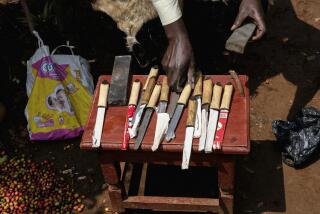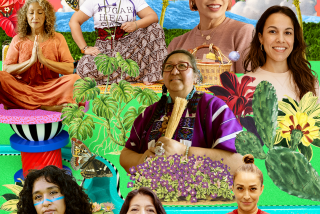COLUMN ONE : ‘Healers’ Adjust to AIDS Era : Millions of black South Africans take their health problems to traditional healers. Now a U.S.-sponsored program is explaining HIV infection to the <i> sangomas, </i> and they are changing their ways.
- Share via
ALEXANDRA, South Africa — In a tiny square room deep in this township, Lucia Mofammere gave a throaty chant and called upon the wisdom of her ancestors. She pierced her patient’s skin with a razor blade and pressed a secret black powder into the wound with a porcupine stiletto.
But, this time, in a new twist on her ancient profession, Mofammere also was relying upon the collective wisdom of Magic Johnson, modern doctors and American AIDS educators.
Heeding their advice, Mofammere wore rubber surgical gloves, discarded her used razor blade and stored the porcupine needle in a cup of disinfectant. Then, when the treatment was finished, she took a plastic phallus from a red silk sack and showed her female patient the proper way to use a condom.
“We’ve changed a bit,” Mofammere explained. “We used to put the muti (medicine) on with our fingers, and we’d use those razor blades again and again. But that was before we found out that HIV is transmitted blood-to-blood.”
All across South Africa, traditional healers--known here as sangomas or inyangas --are changing time-honored practices after taking crash courses on how to identify the symptoms of AIDS, how to prevent its spread and how to protect themselves against contracting it.
Now these crude consulting rooms, where 24 million of South Africa’s 30 million blacks seek herbal and spiritual treatment for everything from mental illness to gonorrhea to high blood pressure, are the newest front in the battle against AIDS on the southern tip of Africa.
Mofammere and more than 200 other African healers have learned valuable lessons in weeklong AIDS workshops across the country. And 500 more sangomas already have signed up for future seminars.
“They come here thinking that AIDS is caused by one of the evil spirits,” said Bongie Zokwe, deputy director of the AIDS Public Health Communications Project and a seminar leader. “I don’t deny that. But we tell them what happens when the virus spreads in the body. We teach them to know what AIDS is.”
The seminars, part of a $500,000 project sponsored by the U.S. Agency for International Development, are taking aim at an important, but often ignored, segment of the health care field in South Africa.
“Traditional healers don’t have the cure for AIDS, but they can treat the symptoms,” Zokwe said. “And people have confidence in them. They have very high credibility in the community.”
In the case of AIDS, a disease for which there is no known cure, traditional healers often have better success treating patients than modern doctors do.
“Their counseling is 100% better than a doctor’s,” Zokwe said. “They don’t start by saying, ‘Why are you sick?’ They start with your social problems--family, work. A modern doctor doesn’t have time for that.”
An estimated 300,000 South Africans, most of them black heterosexuals, are infected with the virus that causes AIDS, and that figure is growing by 300 a day. A respected insurance analyst predicts that one in four adults in the country will be infected with HIV when the disease crests in 2005. So far, about 5,000 cases of full-blown AIDS have been recorded here.
Although this nation has the most advanced system of modern medical care on the continent, more than 80% of black South Africans still visit traditional healers. Those healers have several distinct advantages over their modern counterparts: In addition to their counseling skills, they are available day and night and they are willing to treat patients on credit.
Tens of thousands of traditional healers operate in the townships and rural villages of South Africa, each treating an average of 20 patients a week using techniques passed down through generations.
Sangomas, most of them women, use a mixture of divination, witchcraft and herbs. Inyangas, who are about equally divided between men and women, rely almost exclusively on combinations of some 2,500 varieties of herbs.
The seminars are part of a broad, U.S.-led attempt to bring AIDS education into what workshop leaders call “this magico-religious paradigm of health.”
“In 1988, we asked the government to show us about AIDS,” Mofammere said. “But they didn’t take us seriously. Even now, the white doctors aren’t happy. They still think we are witches.”
Each seminar hosts about 30 sangomas and inyangas, many of whom wear animal skins and beaded bracelets they believe protect them from contracting the diseases they are treating.
In the classroom, the healers learn about the virus that causes AIDS in presentations that include slide shows, graphs on overhead projectors and American videos. After each evening meal, the group breaks into small focus groups to discuss AIDS. And later, the healers get together for what the workshop schedule refers to as “traditional dances and drums.”
Most of the healers have treated sexually transmitted diseases for years and are familiar with the symptoms of AIDS. But few knew the name of this new disease.
“I used to hear there was something called AIDS, but actually I didn’t know what it was,” said Mofammere, 41, a sangoma who has been treating patients in Alexandra, near Johannesburg, for 15 years. “When I saw what this disease was, I realized I had been coming across it for a long time.”
At the seminars, group leaders begin by debunking some of the myths surrounding AIDS. Many traditional healers say they think that the disease was brought into South Africa from a Central African laboratory as part of a sinister plot by President Frederik W. de Klerk to reduce the black population before the first multiracial elections.
“We have to tell them AIDS comes from everywhere, that it could be from any corner of the world and that it doesn’t have a color preference,” Zokwe said.
Traditional healers quickly learn that some of their practices have been contributing to the spread of AIDS from patient to patient--and even from patient to healer.
Many sangomas, such as Mofammere, used razor blades to pierce the skin of their patients, sometimes sucking blood from the resulting wound, then applying muti directly into the bloodstream. The same razor blade often was used on dozens of patients; healers also used their fingers to apply the muti.
“They think they were immune,” Zokwe said. “They believe that, if they are wearing these beads around their wrists, then nothing could affect them. But we tell them that this blood can affect them.”
Of 11 sangomas who have volunteered to be tested, two were HIV-positive.
The message that AIDS is transmitted by blood-to-blood contact has persuaded most of the workshop participants to change their methods, including destroying razor blades after each use, and Mofammere, among others, has begun using porcupine needles to apply muti .
But few come away believing that AIDS is incurable. “I think you can cure it,” Mofammere said. “Especially if you notice it early and if the patient will behave and not run around sleeping with everyone. We are mixing four or five different mutis, and they seem to work.
“But if a person has sores all over, it’s not easy,” she added. “But even then, you can still add some more days to their lives.”
Most traditional healers believe AIDS is a result of promiscuity, a growing problem especially in the urban black townships. But many also think it stems from “dirty blood” caused by sexual practices considered taboo in traditional African culture.
“The white doctors call it AIDS,” Mofammere said. “But with us, AIDS is like this: If you sleep with a woman whose husband has passed away or with a woman during menstruation or with a woman who has had an abortion, their blood is not clean.”
Traditional herbal medicines, which often are the source of modern drugs, have been shown to be effective in treating many of the secondary symptoms of AIDS, such as diarrhea and fevers. And modern doctors all across Africa admit that respected traditional healers often are better equipped than hospitals to counsel patients in advanced stages of the disease.
“Just because someone is HIV-positive doesn’t mean he isn’t still a human being,” Mofammere said. “They are still people. And if we look after them, maybe they will live another few years.”
A more difficult task for the AIDS workers is persuading sangomas and inyangas to dispense condoms and to teach patients the correct way to use them. But they are making progress on that front too.
Traditional healers in the AIDS education seminars are given a phallus and thousands of condoms, along with detailed instructions on how to use them. (“Blow gently into the condom,” Zokwe tells the healers, “to make sure it is pointing the right direction.”)
Mofammere begins her sessions by “throwing the bones,” a collection of goat bones, shells, dice and dominoes she keeps in a drawstring bag made of calfskin. Then she chants and listens to the inner voices of three ancestors who tell her how to treat the patient.
She takes muti from small baby-food jars of black and brown powders that crowd her shelves and puts it in a hollowed-out cow horn. Then she either mixes it with water and asks the patient to drink it or applies it directly into a cut on the patient’s forearm.
Mofammere charges about $7 for a typical treatment and, at the end of each session these days, shows her patients how to use condoms. She dispenses about 100 condoms a day, and her demonstrations draw spectators from miles around.
“Most people think these condoms are something the white man wants them to wear so they won’t have children,” Mofammere said, sitting cross-legged on the floor of her consulting room. “So you have to explain that these are to protect them.”
Others worry that they won’t feel anything during sex. But Mofammere assures them that “the heat is the same.”
Mofammere’s patients are reluctant to disobey her recommendations. In traditional African society, patients believe that they will not be cured unless they strictly follow the instructions of the sangoma.
Although AIDS educators now are reaching traditional healers, they still have difficulty convincing the country’s leaders--black and white--of the inevitability of an AIDS catastrophe.
A high percentage of African National Congress exiles, returning from countries such as Tanzania and Zambia where AIDS already has reached epidemic proportions, are testing positive for HIV. But ANC leaders have been preoccupied with other pressing matters, such as constitutional negotiations and the rising tide of homelessness and poverty.
“South Africans are willing to listen to us, but health is not their priority, especially a mystery virus like this,” said Zokwe, an ANC member.
“My comrades (in the ANC) tell me they are not looking for a new virus, they are looking for a new, democratic South Africa,” she added. “But I tell them that this is a very democratic virus.”
More to Read
Sign up for Essential California
The most important California stories and recommendations in your inbox every morning.
You may occasionally receive promotional content from the Los Angeles Times.














